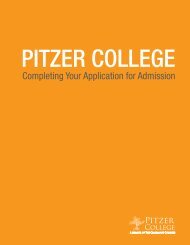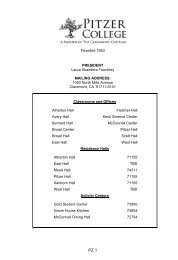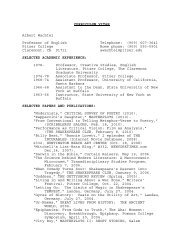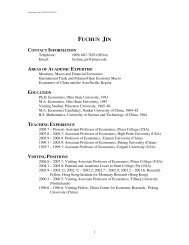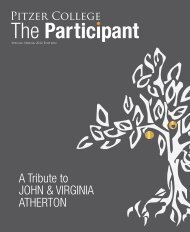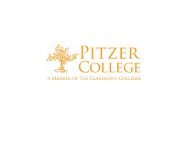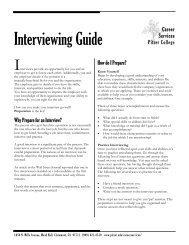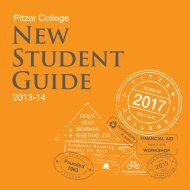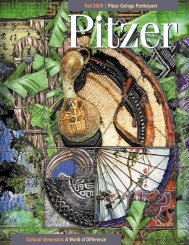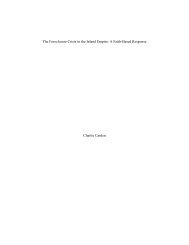Fall 2003 Participant - Pitzer College
Fall 2003 Participant - Pitzer College
Fall 2003 Participant - Pitzer College
Create successful ePaper yourself
Turn your PDF publications into a flip-book with our unique Google optimized e-Paper software.
Joint Science Appointment Fulfills Lifelong Ambition<br />
Jennifer Armstrong knew she wanted to<br />
be a teacher when she was growing up<br />
in Las Cruces, New Mexico. Later, as<br />
a student at New Mexico State working in<br />
a laboratory, she fell in love with biology<br />
and decided to become a scientist. The<br />
marriage of those two passions will have<br />
ample room to grow as a member of the<br />
Joint Science Department.<br />
“Following graduation, I attended<br />
graduate school in San Diego and carried<br />
out my postdoctoral research in Santa<br />
Cruz. I am the only scientist in my family.<br />
I have an aunt who is a philosophy<br />
professor teaching environmental ethics at<br />
Humboldt State,” Armstrong said.<br />
“Since I was a little kid I was sure I<br />
wanted to teach. I used to think about how<br />
I would outline my courses as a professor,”<br />
she said.<br />
She tried the private sector on a<br />
temporary basis and though it was fun<br />
work, she said she knew she wanted to<br />
stay in academia.<br />
“During my post-doctoral studies I<br />
wanted an academic position. When it<br />
came time to look for positions, I applied<br />
very selectively. The Joint Science<br />
Department held an attraction because of<br />
the quality of students and small class sizes<br />
of <strong>Pitzer</strong> and the other <strong>College</strong>s,” she said.<br />
“Besides, the Monterey Bay area is<br />
beautiful, but my husband and I wanted to<br />
return to sunny Southern California.”<br />
Armstrong said the department and<br />
<strong>Pitzer</strong> also hold another attraction.<br />
“I love both teaching and research so<br />
the Joint Science Department of the<br />
Claremont <strong>College</strong>s seems the perfect fit,”<br />
she said. “If you go to a research<br />
Jennifer Armstrong<br />
“My specific field of research is<br />
gene regulation. I am interested<br />
in how genes are turned on and<br />
off at the appropriate times in<br />
development. Diseases [including<br />
cancer] can result when our<br />
genes are not regulated<br />
properly.”<br />
institution, you do mainly research.<br />
Though there’s teaching, it is not stressed.<br />
There’s an opportunity here to use my<br />
research as a teaching tool. That’s the best<br />
way to do science.”<br />
“I really like that in the department<br />
everyone works together so it leads to a lot<br />
of interdisciplinary interaction. Another<br />
asset is that <strong>Pitzer</strong> students also focus on<br />
humanities and social sciences. Such<br />
interaction can really help me open up as a<br />
scientist. I look forward to seeing how I<br />
develop as teacher and a scientist,”<br />
Armstrong said.<br />
Armstrong said she is looking forward<br />
to her first year. She will be teaching<br />
several biology courses and laboratories, as<br />
well as directing students’ Senior Theses.<br />
“My specific field of research is gene<br />
regulation. I am interested in how genes<br />
are turned on and off at the appropriate<br />
times in development,” Armstrong said.<br />
“Diseases [including cancer] can result<br />
when our genes are not regulated properly.<br />
I find this field utterly fascinating, and am<br />
particularly fond of my model organism,<br />
the fruit fly. The Joint Science Department<br />
will allow me to continue research with the<br />
help of student research assistants, which<br />
is of great benefit during the course of<br />
their education.”<br />
And what does she hope to teach these<br />
students? “I aim to convey to students that<br />
we really don’t know what our<br />
experiments will tell us, but that whatever<br />
the answer may be it will contribute to the<br />
body of knowledge about the world and<br />
ourselves.”<br />
“I look forward to meeting the <strong>Pitzer</strong><br />
students who join me in my classes and<br />
my research laboratory, and will do my<br />
best to provide them with positive<br />
experiences that they can carry with them<br />
for years to come,” Armstrong added.<br />
Most of all, Armstrong stressed that she<br />
hopes to be an inspiring role model for all<br />
students. “I want them to know science can<br />
be a good thing,” she said.<br />
Jay Collier<br />
CALDERON<br />
Continued from Page 9<br />
until graduation, faculty participants are in a<br />
better position to sustain campus-community<br />
partnerships.<br />
As these long-term campus-community<br />
partnerships are developed, students and<br />
faculty can become a political force in their<br />
communities. They no longer have to be<br />
placed in the role of travelers passing by.<br />
Instead, they can see themselves as<br />
participants with a stake in the decisions being<br />
made.<br />
Conclusion<br />
The participatory style of learning and<br />
research takes into consideration the meaning<br />
of community—which, as a whole, is made<br />
up of many competing interests. Those who<br />
are corporate growers, developers, and<br />
polluters call themselves part of the<br />
“community,” although their profit-making<br />
interests often place them in conflict with<br />
“quality of life” initiatives in the community.<br />
The “communities” to which I refer are<br />
geographical, political, and spiritual places<br />
that are very diverse. They have different<br />
levels of stratification, power relations,<br />
backgrounds, and ideologies. These<br />
communities are facing inequality or they are<br />
trying to improve their quality of life. Hence,<br />
the research and learning described above<br />
focuses on the sources of inequalities and on<br />
what can be done about them. While the<br />
dominant understanding of inequality tends<br />
to blame the “individual” for his or her<br />
“inadequacies,” other theories and<br />
explanations focus on the historical and<br />
systemic foundations of inequality. The<br />
practices I have described stand with the<br />
latter. They challenge students and faculty to<br />
See Calderon, Page 20<br />
<strong>Fall</strong> <strong>2003</strong> 19



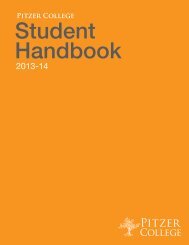

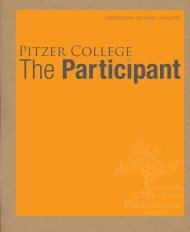
![Anticipated Courses SP14 [pdf] - Pomona College](https://img.yumpu.com/25363335/1/190x245/anticipated-courses-sp14-pdf-pomona-college.jpg?quality=85)
